六年级英语上册基础训练自主学习指导课程答案(1)
- 格式:doc
- 大小:6.92 MB
- 文档页数:10
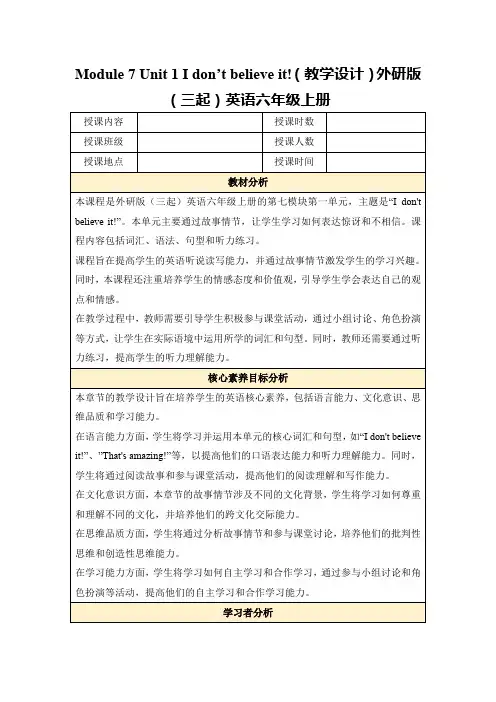
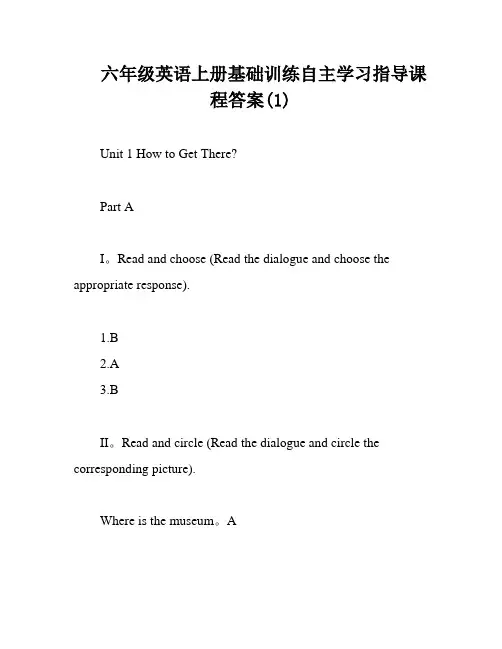
六年级英语上册基础训练自主学习指导课程答案(1)Unit 1 How to Get There?Part AI。
Read and choose (Read the dialogue and choose the appropriate response).1.B2.A3.BII。
Read and circle (Read the dialogue and circle the corresponding picture).Where is the museum。
AIII。
Read and choose (Read the dialogue and choose the appropriate answer).1.B2.A3.BIV。
Look。
write and say (Look at the map。
write the answer and say it).1.Is there a bookstore on the map?Yes。
there is.2.Where is the science museum?It's behind the cinema.3.Where is the hospital?It's in front of the school.4.Where is the post office。
I want to send a postcard.It's next to the cinema.V。
Read and circle (Read the picture and circle the corresponding n).AVI。
Look。
read and choose (Look at the picture。
read the sentence and choose the appropriate one).1.B2.A3.A4.A5.BVII。
Read and finish the map (Read the map and complete it).Can you finish the puzzle?Bookstore Science museum Library Park Post office Cinema Hospital SchoolPart BI。
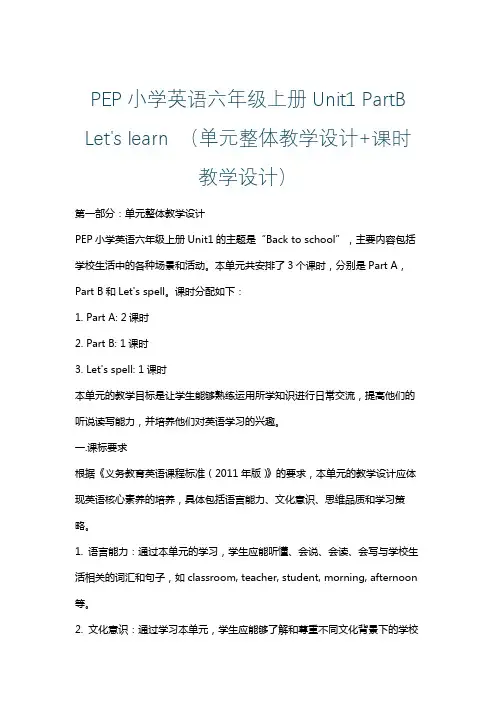
PEP小学英语六年级上册Unit1 PartB Let's learn (单元整体教学设计+课时教学设计)第一部分:单元整体教学设计PEP小学英语六年级上册Unit1的主题是“Back to school”,主要内容包括学校生活中的各种场景和活动。
本单元共安排了3个课时,分别是Part A,Part B和Let's spell。
课时分配如下:1. Part A: 2课时2. Part B: 1课时3. Let's spell: 1课时本单元的教学目标是让学生能够熟练运用所学知识进行日常交流,提高他们的听说读写能力,并培养他们对英语学习的兴趣。
一.课标要求根据《义务教育英语课程标准(2011年版)》的要求,本单元的教学设计应体现英语核心素养的培养,具体包括语言能力、文化意识、思维品质和学习策略。
1. 语言能力:通过本单元的学习,学生应能听懂、会说、会读、会写与学校生活相关的词汇和句子,如classroom, teacher, student, morning, afternoon 等。
2. 文化意识:通过学习本单元,学生应能够了解和尊重不同文化背景下的学校生活,提高他们的跨文化交际能力。
3. 思维品质:本单元的教学设计应引导学生进行观察、分析、推理和判断等思维活动,如通过图片预测内容,通过关键词归纳总结等。
4. 学习策略:学生应能够运用有效的学习策略进行自主学习,如预习、复习、合作学习等,提高他们的学习效率。
二.单元内容分析PEP小学英语六年级上册Unit1的主题为“Back to school”,旨在帮助学生回顾和适应学校生活,同时也为整个学期的学习打下坚实的基础。
本单元主要包括三个部分:Part A, Part B和Let's spell。
1. Part APart A包含两课时,主要介绍学校生活中的常见场景和人物,如classroom, teacher, student等。
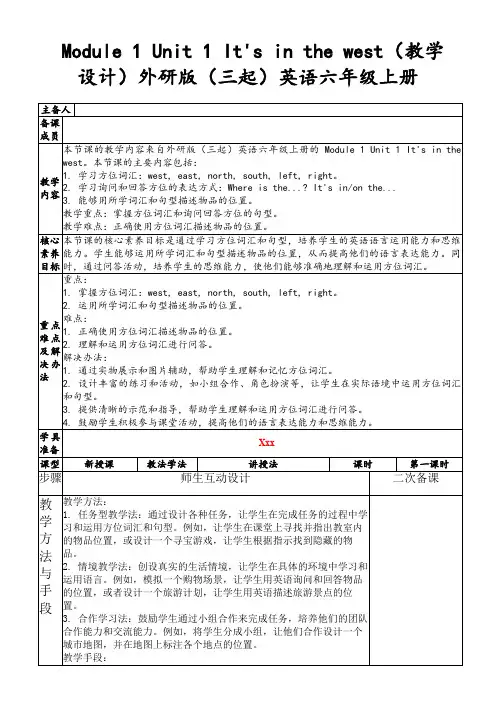
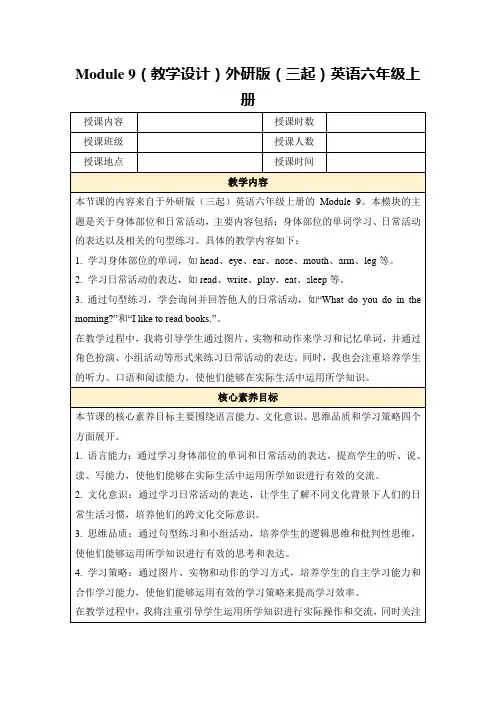
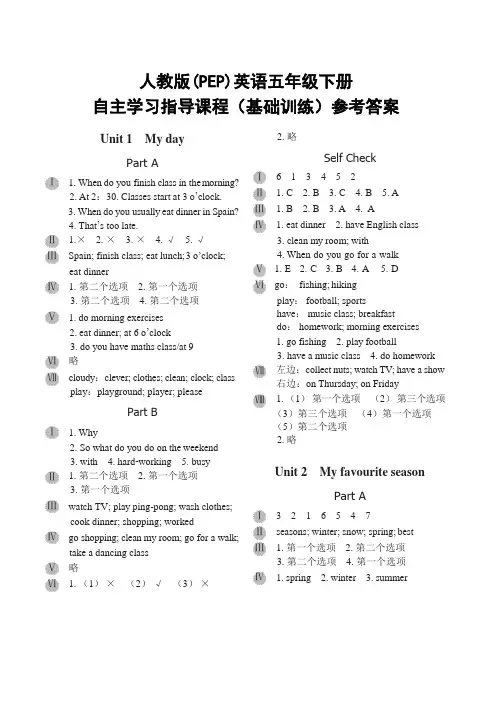
人教版(PEP)英语五年级下册自主学习指导课程(基础训练)参考答案Unit 1 My dayPart A 2. 略Self Check1.When do you finish class in the morning?2.At 2:30. Classes start at 3 o’clock.3.When do you usually eat dinner in Spain?4.That’s too late.Ⅱ 1.× 2. × 3. × 4. √ 5. √ⅢSpain; finish class; eat lunch; 3 o’clock;eat dinner1. 第二个选项2. 第一个选项3. 第二个选项4. 第二个选项1.do morning exercises2.eat dinner; at 6 o’clock3.do you have maths class/at 9Ⅵ略Ⅶcloudy:clever; clothes; clean; clock; class play:playground; player; pleasePart B1.Why2.So what do you do on the weekend3.with4. hard-working5. busy1. 第二个选项2. 第一个选项3. 第一个选项watch TV; play ping-pong; wash clothes;cook dinner; shopping; workedgo shopping; clean my room; go for a walk;take a dancing classⅤ略Ⅵ 1. (1)×(2)√(3)×Ⅰ 6 1 3 4 5 2Ⅱ 1. C 2. B 3. C 4. B 5. AⅢ 1. B 2. B 3. A 4. AⅣ 1. eat dinner 2. have English class3.clean my room; with4.When do you go for a walkⅤ 1. E 2. C 3. B 4. A 5. DⅥgo:fishing; hikingplay:football; sportshave:music class; breakfastdo:homework; morning exercises1. go fishing2. play football3. have a music class4. do homework左边:collect nuts; watch TV; have a show右边:on Thursday; on Friday1.(1)第一个选项(2)第三个选项(3)第三个选项(4)第一个选项(5)第二个选项2.略Unit 2 My favourite seasonPart A3 2 1 6 54 7Ⅱseasons; winter; snow; spring; bestⅢ 1. 第一个选项 2. 第二个选项3.第二个选项4. 第一个选项1. spring2. winter3. summerⅠⅣⅤⅠⅡⅢⅣⅦⅧⅠⅣ4. autumn1. summer2. Which season; spring3.Which season do you like best; autumnbest4.Which season do you like best; I likewinter best1. green2. apple3. blown4. plate1. green grapes2. brown3. Brother; grass4. breakfastPart B1.Look at my picture2.I like autumn best3.Which season do you like best, Miss White?4.Because I like summer vacationⅡ 1. B 2. A 3. AⅢcolours; autumn; good; beautiful; summer;summer vacation1. 第二个选项2. 第一个选项3. 第二个选项1.spring; go on a picnic2.summer; go swimming every day3.autumn; pick apples4.winter; make a snowman1.Which season do you like best?I like autumn best.Why do you like autumn, Zoom?I can pick fresh apples.2.summer; swimming; autumn; pick freshapples; autumn; summer; hotZoom:autumnZip:summerSelf CheckⅠ 1. B 2. A 3. A 4. C 5. AⅡ 1. A 2. B 3. A 4. B 5. BⅢ 1. winter 圈A2.summer; go swimming 圈B3.Which season; pick apples 圈A4.spring; go on a picnic圈BⅣ 1. A 2. B 3. A 4. B 5. AⅤ 1. Where 2. Which 3. When4. What5. WhyⅥ略Ⅶs pring; go on a picnicsummer; go swimmingAutumn; pick appleswinter; make a snowmanWhich season do you like best?I like summer.Because I like summer vacation.Unit 3 My school calendarPart A5 2 1 4 3 6Ⅱ略Ⅲ 1. No, it isn’t. 2. Yes, it is. 3. May4. January5. When is English party6. It’s in January and FebruaryⅣ略Ⅴ 1. √ 2. √ 3. × 4. × 5. ×Ⅵ 1. teacher; China 2. shirt; shorts3. fish; lunch4. sheep; chickenChina:teacher; lunch shorts:shirt; fish; sheep略Part BI like autumn, too.We can have a school trip.When is the trip this year?We’ll go to the Great Wall.Ⅱ略Ⅲ 1. B 2. B 3. A 4. A 5. AⅣ 1. (1)F (2)T (3)F (4)T2. I will plant trees. I will eat eggs.ⅤⅥⅦⅠⅣⅤⅥⅠⅦⅠI will go hiking with my parents.I will swing with my friends.I will fly kites.1. in2. on3. at4. in5. onSelf CheckⅠ 1. B 2. A 3. A 4. B 5. BⅡ 1. B 2. B 3. A 4. A 5. A1.When is; It’s in September2.autumn3. Thank you shirts:Sherry; shop; shoes; sharpenerchicken:chip; chop; Charlie1.It is usually in June.2.They will have a dragon boat race.They will cut Chinese mugwort and putit on the door.They will have a spice bag.April:He will make a summer vacation p lan.July:He will visit his grandparents.August:He will go to Huangshan Moutain.略Recycle 11. plate2. class3. grown4. green5. cheap6. fishⅡ 1 5 3 6 4 2Ⅲ 1. April 2. December 3. July4. October5. February1. 第三个选项2. 第二个选项3. 第三个选项4. 第三个选项5. 第三个选项6. 第三个选项7. 第三个选项8. 第二个选项1. frog2. skirt3. black4. please5. grow6. shy略Ⅶ略ⅧSummer; winter; get up; summer; way;go to bed;day; see; The birds; the tree;feet;street; clear and blue;play; day略Unit 4 When is the art show?Part AⅠWhat; When; on; May 5th; loveⅡ 1. B 2. C 3. A 4. BⅢ 1. first 2. second 3. third 4. fourth5. fifth1. sports meet2. When; on3. October 3rd4. When is the school trip5. It’s on December 2ndMay 1st; July 4th; October 3rd; November5th; December 2nd1.略2.thirteen:three; birthday; Cathy; third;fifthTheir:there; the; father; mother3.A C B4. (1)B (2)B (3)B (4)APart BⅠWhen; April 4th; What; cook noodles; have Ⅱ 1. A 2. A 3. B 4. B 5. BⅢ略Ⅳ 1. 第二选项 2. 第一选项ⅤJan. 12th; Oct. 30th; Apr. 4th; Aug. 20th Ⅵ 1. twenty-third 2. fourth 3. twelfth4.twentiethⅦ 1. × 2. × 3. × 4. × 5. √Ⅷ 1. 3 2 4 12. (1)第二选项(2)第一选项(3)第一选项Self CheckⅠ 3 1 2 5 4Ⅱ 1. B 2. A 3. A 4. A 5. BⅤⅢⅣⅤⅥⅦⅠⅣⅤⅥⅨⅣⅤⅥ1. 第一个选项2. 第二个选项3. 第一个选项4. 第二个选项5. 第一个选项Ⅳbirthday; 3rd; mother’s; WhatⅤ 1. three 2. first 3. eleven 4. 8th5. fifthⅥ 1. 第二个选项 2. 第二个选项3. 第二个选项5. 第二个选项7. 第一个选项4. 第二个选项6. 第一个选项Ⅶtwelve; twelfth; third; four; seven; firstⅧ 1. (1)T (2)F2. 略Unit 5 Whose dog is it?Part AⅠthese; beautiful; Whose; Shanghai; hisⅡ 1. T 2. T 3. F 4. Fwe:our; ours you:your; yourshe:his; hisshe:her; hers they:their; theirs1. hers2. his3. yours4. ours5. Theirs1. her2. my; yours3. He; His4. mine; My5. Whose; yours; theirsyour; hers; yours; his; mine; Whose 1.B 2. B 3. A 4. A 5. APart BⅠ B C AⅡChen Jie; kitchen; eating; drinking water;play with; parksleeping; climbing; jumping; drinking;reading; playing; running1. Yes, he is.2. No, it isn’t.3. They are running.4. No, they aren’t.Ⅴ略Ⅵ 1. Yes, there is. 2. It’s running.3. They are climbing trees.4. No, it isn’t.5. They are playing with each other undera big tree.Self Check5 4 1 3 2Ⅱ 1. C 2. B 3. A 4. C 5. CⅢ 1. B 2. A 3. C 4. A 5. BⅣ 1. Whose book is this?2.Is he climbing?3.They are drinking water.4.Are these all ours?1. yours; mine2. his; hers3. Their; Ours4. Whose; his; my5. Our; theirs1. Whose is it?2. It’s in the living room.3.Is he drinking water?4.What is she doing?5.They are listening to music.1. 第一幅图2. 第一幅图3. 第二幅图4. 第二幅图5. 第二幅图trunk:trunk; bank; drink; pink; ink; thanklong:long; sing; song; Young; thing; ring1. F2. F3. F4. T5. TUnit 6 Work quietly!Part AⅠ8 7 2 5 4 3 6 1Ⅱ 1. 第二个选项 2. 第二个选项3. 第一个选项Ⅲ1—E 2—D 3—C 4—B 5—AⅣ略Ⅴ 1. doing morning exercises2. having a class3. eating lunchⅢⅢⅣⅤⅥⅦⅢⅣⅠⅤⅥⅦⅧⅨ4. reading a book5. listening to musicⅣNo eating; talk quietly; keep to the right;Ⅵ 1. Where 2. What 3. When 4. Who5. WhoseWhy do you like summer?keep your desk clean; doing morning exercises; having a class; reading a book; listening to musicⅦ 1. What 2. When 3. Where 4. Whose5. Who Ⅴ 1. eating bananas 2. Zoom3. talk quietly4. keep cleanⅧ 1. 第一个选项 2. 第一个选项3. 第一个选项4. 第一个选项ⅥⅦ略1. washing; watering; watching; studying;5. 第一个选项Part Beating; happy 2.略Talk quietly; read the books; Keep yourdesk cleanⅡ 1. 第二个选项 2. 第二个选项Ⅲ D C B AⅣ 1. talk quietly 2. take turns3.keep to the right4.keep your desk clean1. drawing a picture2. making sushi3. playing music4. doing kung fu1. reading2. playing3. cleaning4. is sleeping5. eat breakfast1. (1)F (2)T (3)T (4)F(5)T2.standing under the trees and looking attheir children; flying a kite; reading a book;drinking milk; at schoolSelf CheckⅠ 5 4 3 2 1Ⅱ 1. B 2. A 3. A 4. A 5. BWhat are you doing; reading a book;watching TV; ChineseRecycle 2Ⅰ 1 2 3 4 5Ⅱ 1. drawing pictures 2. do kung fu3.make a snowman4. December5. keep quietⅢ略Ⅳ 1. E 2. D 3. C 4. B 5. AⅤ 1. Dec. 25th 2. May 1st 3. Sept. 10th4. Jun. 1st5. Mar. 8th652431Ⅵ 1. A 2. A 3. B 4. A 5. BⅦt hree:birthdays; thinkwhen:what; whypink:think long:doingbrother:mother; father(A)1. B 2. A 3. C 4. C 5. A(B)grandma; father and mother; I and Andy略ⅠⅤⅥⅦⅢⅧⅨ。
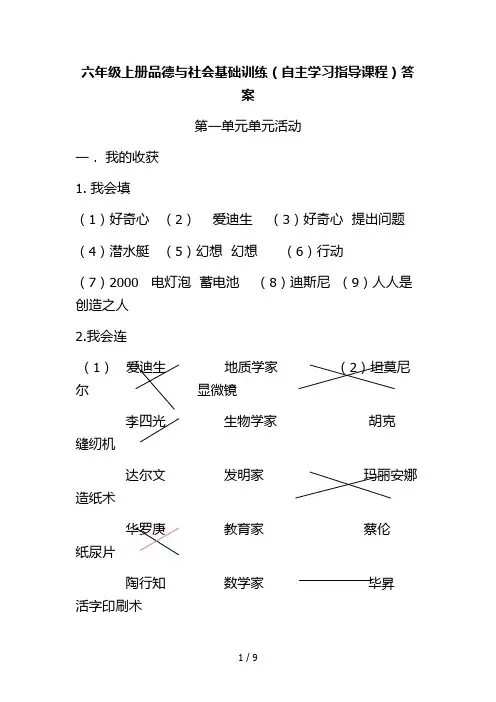
六年级上册品德与社会基础训练(自主学习指导课程)答案第一单元单元活动一.我的收获1.我会填(1)好奇心(2)爱迪生(3)好奇心提出问题(4)潜水艇(5)幻想幻想(6)行动(7)2000 电灯泡蓄电池(8)迪斯尼(9)人人是创造之人2.我会连(1)爱迪生地质学家(2)坦莫尼尔显微镜李四光生物学家胡克缝纫机达尔文发明家玛丽安娜造纸术华罗庚教育家蔡伦纸尿片陶行知数学家毕昇活字印刷术3.我会答答:我认为失败是成功之母。
失败并不可怕,就像爱迪生研制灯泡一样,他遇到了许多次失败,关键是从失败中吸取教训。
二、生活广角1. 成功离不开行动,达尔文取得的成就和他善于发现善于观察有关,我们也应该做生活有心人,善于发现,将梦想付诸行动。
2.这种观点不对。
创造之路并不平坦,充满挫折,只有经受住失败考验,才能成功。
小明妈妈说的不对。
科学幻想是创造的开始,是进行科学探索的动力和基础,幻想会通过创造变成现实。
三、反思回顾我最喜欢“从家务劳动中发现创造机会”活动,因为我通过活动想到了许多新点子。
不足:不爱发言/发言不够条理/倾听同学发言不认真。
第二单元从田野到车间1.让田野告诉你课前体验(10页)我的资料:如今农业生产大部分实现了机械化,比如种麦子、收麦子都用机械进行,省时省力。
我的感想:科技促进了农业发展,伟农民伯伯提供了方便。
课堂连线说一说:麦子播种——施肥——打药——灌溉——收割——晾晒农民伯伯种粮食真辛苦,我会努力学习,为农业生产发明更多机械,方便生产。
想一想:周总理是我们勤俭节约的榜样,在生活中我们应该珍惜粮食,做到不浪费。
议一议:小丽说得对。
小小一粒米包含了农民伯伯的辛勤汗水,我们不应该浪费。
同时如果每个人都像小军这样做,浪费是巨大的。
写一写:春不种,秋无收。
日落乌云洞,明朝晒得背皮痛。
天上起了鲤鱼斑,明天晒谷不用翻。
立夏勿下雨,犁耙倒挂起。
寒露无青稻,霜降一齐老。
稻田水多是糖浆,麦田水多是砒霜。
人靠饭养,稻靠肥长。
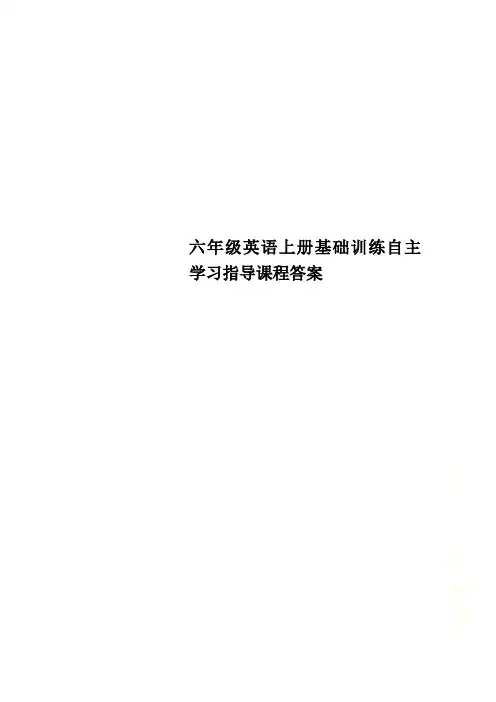
六年级英语上册基础训练自主学习指导课程答案六年级英语下册基础训练“自主学习指导课程”参考答案(1)目录本文档适用的配套图书说明:本文档为本配套图书1~31页的答案封面目录 (1)Unit 1 How can I get there? 参考答案...............第2~4页Unit 2 Ways to go to school参考答案.....................第5~7页Unit 3 My weekend plan参考答案........................第8~9页Recycle 1 参考答案 (10)Unit 1 How can I get there?Part AI. Read and choose(读一读,给对话泡中的句子选择合适的答语吧).Ⅱ. Read and circle(阅读上面的对话,选出相对应的图片).Where is the museum? AⅢ. Read and choose(阅读上面的对话,选出相应的答案).1. B2. A3. BⅣ. Look, write and say(看一看,写一写,说一说).1. —Is there a bookstore in the map?—Yes, there is.2. —Where is the science museum?—It’s behind the cinema.3. —Where is the hospital?—It’s in front of the school.4. —Where is the post office? I want to send a postcard.—It’s next to the cinema.Ⅴ. Read and circle(读图,圈出与图片相对应的选项).AⅥ. Look, read and choose(看一看,读一读,选出句子所描述的图画).1. B2. A3. A4. A5. BⅦ. Read and finish the map(读一读,完成地图).Can you finish the puzzle?books cine hosp sciencemuselibraparpostschooPart BI. Read and choose(读一读,将所缺句子的代号填写在横线上).D C B AⅡ. Read and choose(根据上面的对话,选出相应的答案).1. A2. B3. AⅢ. Read and judge(根据上面的对话,判断对“√”错“×”).1.√2.×3.√Ⅳ. Read and choose(为下列单词或短语选择正确的图片).1. C2. B3. D4. AⅥ. Read and write(读一读,写一写).First,go straight on the Long Street. Then turn right at the second crossing.The hospital is next to the cinema on the right. Then go straight. You can see the library at the end of the road.Ⅶ. Read, find and write(Mr Black要去几位同学家家访,你能根据路线写出Mr Black去哪几位同学家吗?)1. Liu Yun’s2. Bai Ling’sⅧ. Read number(读课本第8页Read and write, 选出相应的图片).AⅨ. Look and write(看一看,写一写).First, go straight. Turn right at the second crossing. Go straight again. Then turn left at the supermarket. Go straight and you can see our school on your right.Self checkⅠ. Listen and number(听录音,给下列图片排排序吧).略。
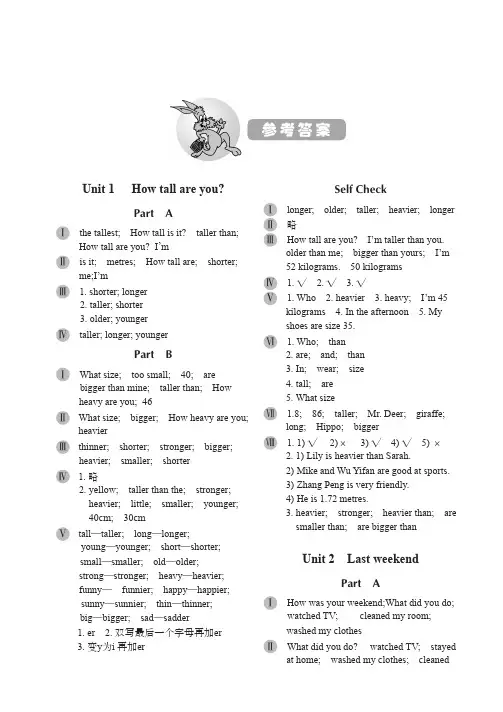
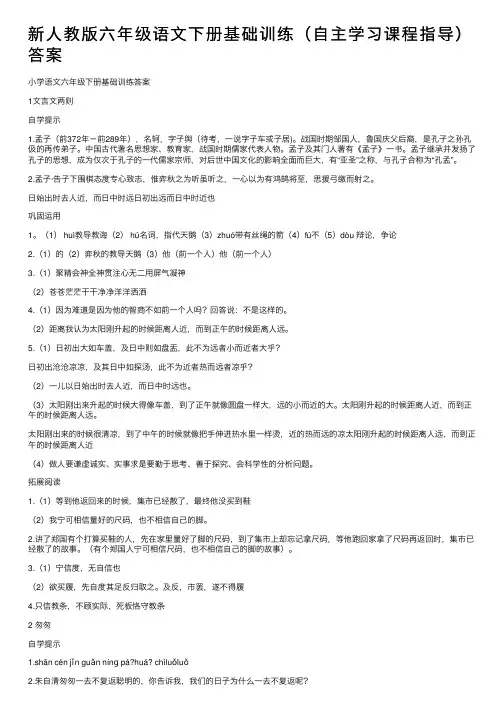
新⼈教版六年级语⽂下册基础训练(⾃主学习课程指导)答案⼩学语⽂六年级下册基础训练答案1⽂⾔⽂两则⾃学提⽰1.孟⼦(前372年-前289年),名轲,字⼦舆(待考,⼀说字⼦车或⼦居)。
战国时期邹国⼈,鲁国庆⽗后裔,是孔⼦之孙孔伋的再传弟⼦。
中国古代著名思想家、教育家,战国时期儒家代表⼈物。
孟⼦及其门⼈著有《孟⼦》⼀书。
孟⼦继承并发扬了孔⼦的思想,成为仅次于孔⼦的⼀代儒家宗师,对后世中国⽂化的影响全⾯⽽巨⼤,有“亚圣”之称,与孔⼦合称为“孔孟”。
2.孟⼦·告⼦下围棋态度专⼼致志,惟弈秋之为听虽听之,⼀⼼以为有鸿鹄将⾄,思援⼸缴⽽射之。
⽇始出时去⼈近,⽽⽇中时远⽇初出远⽽⽇中时近也巩固运⽤1。
(1) huì教导教诲(2) hú名词,指代天鹅(3)zhuó带有丝绳的箭(4)fú不(5)dòu 辩论,争论2.(1)的(2)弈秋的教导天鹅(3)他(前⼀个⼈)他(前⼀个⼈)3.(1)聚精会神全神贯注⼼⽆⼆⽤屏⽓凝神(2)苍苍茫茫⼲⼲净净洋洋洒洒4.(1)因为难道是因为他的智商不如前⼀个⼈吗?回答说:不是这样的。
(2)距离我认为太阳刚升起的时候距离⼈近,⽽到正午的时候距离⼈远。
5.(1)⽇初出⼤如车盖,及⽇中则如盘盂,此不为远者⼩⽽近者⼤乎?⽇初出沧沧凉凉,及其⽇中如探汤,此不为近者热⽽远者凉乎?(2)⼀⼉以⽇始出时去⼈近,⽽⽇中时远也。
(3)太阳刚出来升起的时候⼤得像车盖,到了正午就像圆盘⼀样⼤,远的⼩⽽近的⼤。
太阳刚升起的时候距离⼈近,⽽到正午的时候距离⼈远。
太阳刚出来的时候很清凉,到了中午的时候就像把⼿伸进热⽔⾥⼀样烫,近的热⽽远的凉太阳刚升起的时候距离⼈远,⽽到正午的时候距离⼈近(4)做⼈要谦虚诚实、实事求是要勤于思考、善于探究、会科学性的分析问题。
拓展阅读1.(1)等到他返回来的时候,集市已经散了,最终他没买到鞋(2)我宁可相信量好的尺码,也不相信⾃⼰的脚。
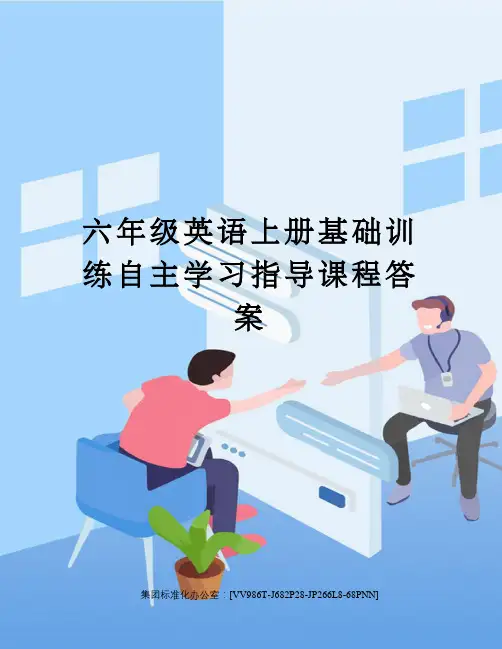
六年级英语上册基础训练自主学习指导课程答案集团标准化办公室:[VV986T-J682P28-JP266L8-68PNN]六年级英语下册基础训练“自主学习指导课程”参考答案(1)目录本文档适用的配套图书说明:本文档为本配套图书1~31页的答案封面目录……………………………………………………第 1页Unit 1 How can I get there? 参考答案……………第2~4页Unit 2 Ways to go to school参考答案…………………第5~7页Unit 3 My weekend plan参考答案……………………第8~9页Recycle 1 参考答案 (10)Unit 1 How can I get there?Part AI. Read and choose(读一读,给对话泡中的句子选择合适的答语吧).Ⅱ. Read and circle(阅读上面的对话,选出相对应的图片).Where is the museumAⅢ. Read and choose(阅读上面的对话,选出相应的答案).1. B2. A3. BⅣ. Look, write and say(看一看,写一写,说一说).1. —Is there a bookstore in the map?—Yes, there is.2. —Where is the science museum?—It’s behind the cinema.3. —Where is the hospital—It’s in front of the school.4. —Where is the post office I want to send a postcard.—It’s next to the cinema.Ⅴ. Read and circle(读图,圈出与图片相对应的选项).AⅥ. Look, read and choose(看一看,读一读,选出句子所描述的图画).1. B2. A3. A4. A5. BⅦ. Read and finish the map(读一读,完成地图).Can you finish the puzzle?).Ⅱ. Read and choose(根据上面的对话,选出相应的答案).1. A2. B3. AⅢ. Read and judge(根据上面的对话,判断对“√”错“×”).1.√2.×3.√Ⅳ. Read and choose(为下列单词或短语选择正确的图片).1. C2. B3. D4. AⅥ. Read and write(读一读,写一写).First,go straight on the Long Street. Then turn right at the second crossing. The hospital is next to the cinema on the right. Then go straight.You can see the library at the end of the road.Ⅶ. Read, find and write(Mr Black要去几位同学家家访,你能根据路线写出Mr Black 去哪几位同学家吗)1. Liu Yun’s2. Bai Ling’sⅧ. Read number(读课本第8页Read and write, 选出相应的图片).AⅨ. Look and write(看一看,写一写).First, go straight. Turn right at the second crossing. Go straight again. Then turn left at the supermarket. Go straight and you can see our school on your right.Self checkⅠ. Listen and number(听录音,给下列图片排排序吧).略。
《小学英语课程标准》试题(一)一、填空(共10分)1.基础教育阶段英语课程的总体目标是培养学生的综合语言运用能力。
2.基础教育阶段英语课程目标的各个级别均以学生语言技能、语言知识、情感态度、学习策略和文化意识五个方面的综合行为表现为基础进行总体描述。
3.语言技能包括听、说、读、写四个方面的技能以及这四种技能的综合运用能力。
4.新课程的最高宗旨和核心理念是一切为了学生的发展5.学习策略指学生为了有效地学习和发展而采取的各种行动和步骤。
英语学习的策略包括认知策略、调控策略、交际策略和资源策略等。
6.3一6年级英语教学评价的主要目的是激励学生的学习兴趣和积极性。
评价形式应具有多样性和可选择性。
评价应以形成性评价为主,以学生平时参与各种教学活动的表现和合作能力为主要依据。
7.英语课程在目标设定、教学过程、课程评价和教学资源的开发等方面都突出以学生为主体的思想。
8.从3年级开设英语课程的学校,5、6年级完成二级目标;9.《标准》以学生“能做某事”的描述方式设定各级目标要求。
教师应该避免单纯传授语言知识的教学方法,尽量采用“任务型”的教学途径。
10.教师要充分利用现代教育技术,开发英语教学资源,拓宽学生学习渠道,改进学生学习方式,提高教学效果。
二、判断正误1.小学英语教学要创建以活动课为主的教学模式,充分利用听、做、说、唱、玩、演的方式,鼓励学生积极参与,大胆表达,侧重提高学生对英语的感受和初步用英语进行听、说、唱、演的能力,到了五、六年级也要发展初步的读写能力。
(√)2.小学英语教学的目标共分两段,一级的目标类别是语言技能方面的听做、说唱、读写、视听;二级语言技能的目标是听、说、读、写、玩、演、视听。
此外,二级还有语言知识目标———语音、词汇、语法、功能、话题、情感态度目标、基本学习策略目标、文化意识目标。
(√)3.小学英语语言技能二级读的目标中,要求能认读所学词语;能根据拼读的规律读出简单的单词;能借助图片读懂简单的故事或小短文,并养成按意群阅读的习惯。
六年级英语下册基础训练“自主学习指导课程”参考答案(1)目录本文档适用的配套图书说明:本文档为本配套图书1~31页的答案封面目录 (1)Unit 1 How can I get there? 参考答案...............第2~4页Unit 2 Ways to go to school参考答案.....................第5~7页Unit 3 My weekend plan参考答案........................第8~9页Recycle 1 参考答案 (10)Unit 1 How can I get there?Part AI. Read and choose(读一读,给对话泡中的句子选择合适的答语吧).Ⅱ. Read and circle(阅读上面的对话,选出相对应的图片).Where is the museum? AⅢ. Read and choose(阅读上面的对话,选出相应的答案).1. B2. A3. BⅣ. Look, write and say(看一看,写一写,说一说).1. —Is there a bookstore in the map?—Yes, there is.2. —Where is the science museum?—It’s behind the cinema.3. —Where is the hospital?—It’s in front of the school.4. —Where is the post office? I want to send a postcard.—It’s next to the cinema.Ⅴ. Read and circle(读图,圈出与图片相对应的选项).AⅥ. Look, read and choose(看一看,读一读,选出句子所描述的图画).1. B2. A3. A4. A5. BⅦ. Read and finish the map(读一读,完成地图).Can you finish the puzzle?bookstorecinemahospitalsciencemuseumlibraryparkpost officeschoolPart BI. Read and choose(读一读,将所缺句子的代号填写在横线上).D C B AⅡ. Read and choose(根据上面的对话,选出相应的答案).1. A2. B3. AⅢ. Read and judge(根据上面的对话,判断对“√”错“×”).1.√2.×3.√Ⅳ. Read and choose(为下列单词或短语选择正确的图片).1. C2. B3. D4. AⅥ. Read and write(读一读,写一写).First,go straight on the Long Street. Then turn right at the second crossing.The hospital is next to the cinema on the right. Then go straight. You can see the library at the end of the road.Ⅶ. Read, find and write(Mr Black要去几位同学家家访,你能根据路线写出Mr Black去哪几位同学家吗?)1. Liu Yun’s2. Bai Ling’sⅧ. Read number(读课本第8页Read and write, 选出相应的图片).AⅨ. Look and write(看一看,写一写).First, go straight. Turn right at the second crossing. Go straight again. Then turn left at the supermarket. Go straight and you can see our school on your right.Self checkⅠ. Listen and number(听录音,给下列图片排排序吧).略。
精选全文完整版(可编辑修改)英语六年级(上)课程纲要学校名称:设计教师:日期:课程名称:小学英语课程类型:学科课程教材来源:PEP人教版适用年级:六年级教学课时:48课时一、课程背景1.教材分析本册教材以《义务教育英语课程标准》(2011年版)为依据,体现英语课程的工具性和人文性的双重属性。
整册书共六个学习单元和两个学习单元,按照每单元6课时编排,每单元包含3个大部分:Part A,PartB和PartC(选学) ,A、B每一部分又分为两个小部分:A中的Let’s talk和Let’s learn. B中的Let’s talk、Let’s learn和Read and write. 六年级的教材与四、五年级的比较,在单元结构上发生了变化:从六年级开始去掉了Let’s spell板块,设计了新的小板块Let’s try、Let’s wrap it up和Tips for pronunciation. Let’s try是一个听力练习,通过听音、看图、理解关键词等,感知Let’s talk部分的新句型,从而引入新句型的学习。
Let’s wrap it up是对每一单元出现的语法知识的小总结。
Tips for pronunciation部分由原来的字母组合朗读和绕口令新欣赏过渡到连读、重读、爆破和意群的练习。
本册教材话题大都是前六册曾出现的旧话题,这样的安排可以不断滚动复现旧话题、融合旧知识,带出新语言,分散、弱化难度,让学生在温故知新的过程中不断展开进一步的学2.学生基本情况分析六年级英语在小学英语教学中起着承上启下的作用,既是五年级的衍生又是初中一年级的铺垫。
六年级学生已经接触了三年英语,有一定的英语基础。
涉及到“问路”的主要句型有“Where is …?”在三和五年级都有方位介词的学习:on,under, in front of, beside, behind, near。
五上U2 《My week》重点学习了一般现在时,现在进行时也学习过,在此基础上开始接触be going to…句型,第四单元涉及的动词短语大部分都是以前曾经学过的:dance, sing, play football, do kung fu. 谈论人物的职业的单词在四年级有涉及到:farmer, nurse, driver, football player.所以在设计教学活动中应考虑学生已有的知识水平,我们在教学中应注意以旧带新,这样能相应在降低教学难度,又能自然地引出新的教学内容,在此基础上适当拓展语言。
英语基础训练六年级上册听录音部分1. 背景介绍英语是一门国际语言,在当今全球化的社会中具有重要地位。
培养学生的英语听力能力是学校英语教学的重要任务之一。
六年级上册的英语课程中,听录音部分是培养学生听力的重要环节,也是评价学生英语综合能力的重要方面。
2. 听录音部分的目的和意义在英语学习中,听力是获取语言信息的重要途径之一。
通过听录音部分的训练,可以帮助学生提高对英语语音、语调的感知和理解能力,培养学生的听力反应能力,提高学生的听力水平,为学生日后的英语学习打下坚实的基础。
3. 听录音部分的内容和要求六年级上册的英语听录音部分主要包括以下内容:听录音,根据所听到的内容进行相应的回答,涉及词汇、问答、短文等不同形式。
要求学生能够准确听出所听内容,正确理解并做出正确的反应。
4. 听录音部分的训练方法和技巧为了帮助学生更好地完成听录音部分的考试,教师可以在日常的课堂教学中,针对听力训练,采用以下方法和技巧进行训练:4.1 注重平时的听力训练。
教师可以在课堂上设置专门的听力训练环节,让学生多次反复听录音,提高学生的反应速度和准确率。
4.2 强调语音语调的感知。
教师可以通过朗读、模仿、对话等形式,帮助学生更好地感知英语的语音语调,增强对所听内容的理解和把握。
4.3 注重听力技巧的培养。
教师可以针对不同形式的听录音部分,向学生介绍相应的听力技巧,帮助学生更好地完成听力测试。
5. 听录音部分的考试评价和反馈在考试中,学生需要根据所听到的内容,做出相应的回答或反应。
教师可以通过对学生的听力测试,及时地进行评价和反馈,指出学生的听力方面存在的问题,帮助学生找到不足之处,及时调整学习方法,加强训练,提高听力水平。
6. 结语英语基础训练六年级上册听录音部分是学生英语学习的重要组成部分,通过听录音的训练,可以帮助学生提高听力水平,为日后的英语学习奠定坚实的基础。
教师和家长都应该重视学生的英语听力训练,为学生提供更多的听力练习机会,帮助他们更好地掌握英语听力的基本技能。
教学目标:1. 知识目标:(1)能够听懂、会说、会读“Recycle1”中的故事,掌握故事中的核心单词和句型。
(2)能够运用所学单词和句型进行简单的日常交流。
2. 能力目标:(1)培养学生的听说能力和语言运用能力。
(2)提高学生的阅读理解能力。
3. 情感目标:(1)培养学生对英语学习的兴趣。
(2)培养学生热爱生活,关注环境保护的意识。
教学内容:1. 教材内容:人教PEP六年级上册英语教材“Recycle1”中的第三个故事。
2. 教学资源:多媒体教学课件、录音机、磁带、故事书、作业本等。
教学重点与难点:1. 教学重点:(1)掌握故事中的核心单词和句型。
(2)能够听懂、会说、会读故事内容。
2. 教学难点:(1)故事中一些较长的句子和复杂的语法结构。
(2)学生能够运用所学单词和句型进行实际交流。
教具与学具准备:1. 教具:多媒体教学课件、录音机、磁带、故事书等。
2. 学具:作业本、笔、笔记本等。
教学过程:Step 1:热身(5分钟)1. 教师与学生用简单的英语进行问候,营造轻松的课堂氛围。
2. 学生听录音,跟读核心单词和句型。
Step 2:新课导入(10分钟)1. 教师通过多媒体课件展示故事情节,引导学生关注故事主题。
2. 学生听故事录音,跟读并模仿语音语调。
3. 教师讲解故事中的一些较长句子和复杂语法结构。
Step 3:课堂活动(10分钟)1. 学生分角色扮演故事中的角色,进行角色扮演练习。
2. 教师组织学生进行小组讨论,让学生运用所学单词和句型进行交流。
Step 4:巩固练习(10分钟)1. 教师出示一些与故事相关的问题,引导学生进行阅读理解练习。
2. 学生完成练习题,教师进行讲解和反馈。
Step 5:作业布置(5分钟)1. 教师布置作业,要求学生课后复习故事内容,巩固所学单词和句型。
板书设计:1. 故事2. 核心单词和句型3. 重点句子和语法结构作业设计:1. 复习故事内容,巩固所学单词和句型。
六年级英语下册基础训练“自主学习指导课程”参考答案(1)目录本文档适用的配套图书说明:本文档为本配套图书1~31页的答案封面目录 (1)Unit 1 How can I get there? 参考答案...............第2~4页Unit 2 Ways to go to school参考答案.....................第5~7页Unit 3 My weekend plan参考答案........................第8~9页Recycle 1 参考答案 (10)Unit 1 How can I get there?Part AI. Read and choose(读一读,给对话泡中的句子选择合适的答语吧).Ⅱ. Read and circle(阅读上面的对话,选出相对应的图片).Where is the museum? AⅢ. Read and choose(阅读上面的对话,选出相应的答案).1. B2. A3. BⅣ. Look, write and say(看一看,写一写,说一说).1. —Is there a bookstore in the map?—Yes, there is.2. —Where is the science museum?—It’s behind the cinema.3. —Where is the hospital?—It’s in front of the school.4. —Where is the post office? I want to send a postcard.—It’s next to the cinema.Ⅴ. Read and circle(读图,圈出与图片相对应的选项).AⅥ. Look, read and choose(看一看,读一读,选出句子所描述的图画).1. B2. A3. A4. A5. BⅦ. Read and finish the map(读一读,完成地图).Can you finish the puzzle?bookstore cinema hospital sciencemuseumlibraryparkpost officeschoolPart BI. Read and choose(读一读,将所缺句子的代号填写在横线上).D C B AⅡ. Read and choose(根据上面的对话,选出相应的答案).1. A2. B3. AⅢ. Read and judge(根据上面的对话,判断对“√”错“×”).1.√2.×3.√Ⅳ. Read and choose(为下列单词或短语选择正确的图片).1. C2. B3. D4. AⅥ. Read and write(读一读,写一写).First,go straight on the Long Street. Then turn right at the second crossing.The hospital is next to the cinema on the right. Then go straight. You can see the library at the end of the road.Ⅶ. Read, find and write(Mr Black要去几位同学家家访,你能根据路线写出Mr Black去哪几位同学家吗?)1. Liu Yun’s2. Bai Ling’sⅧ. Read number(读课本第8页Read and write, 选出相应的图片).AⅨ. Look and write(看一看,写一写).First, go straight. Turn right at the second crossing. Go straight again. Then turn left at the supermarket. Go straight and you can see our school on your right.Self checkⅠ. Listen and number(听录音,给下列图片排排序吧).略。
Ⅱ. Listen and number(听录音,根据录音内容提供的方位找到对应的地点).略。
Ⅲ. Listen fill in the blanks(听录音,补全对话).略。
Ⅳ. Listen and draw(听录音,根据你所听到的内容用箭头画出到学校的路线).略。
Ⅴ. Read and judge( 读一读,判断句子的语音语调是“T”否“F”正确).1. T2. T3. F4. TⅥ. Read and write(读一读,写一写).1. —Where is the hospital ?—It’s near the library.2. —Is there a post office in your city?—Yes, there is.3. —Where is Robin?—It’s in the science museum.4. —How can I get to the cinema?—Go straight, then turn left.5. —How can I get to the restaurant?— First, you can go straight. Then turn right.Ⅶ. Read the passage and do the exercises(读短文,完成题目).Mark True(T) or False(F) (判断对“T”错“F”)1. T2. F3. F4. T5. FAnswer the questions(回答问题).1.It’s next to the cinema.2.He wants to go to the library.3. First, turn left at the science museum. Next, go straight on Dongfang Street.Then cross the first crossing.Ⅷ. Read and answer(读课本11页的Story time, 回答问题).1. It’s next to the film museum near the Thames.2. Go straight and turn left.3. Yes, he does.Unit 2 Ways to go to schoolPart AⅠ.Read and number(读对话,将下列图片按照对话内容标号).Ⅱ.Read and write “T” or “F”(再读上面的短文,判断对“T”错“F”).1. F2. T3.TⅢ. Try to write(试一试,写出3个通顺的句子,你能发现行李箱里的秘密吗)?例:I often come to school on foot.We usually get to the library by bike.She often goes to the cinema by taxi.Ⅳ. Read and circle(看图读句子,圈出正确描述图片的句子).1. A2. B3. AⅤ. Find and write(找到每个人去某地的方式,将下面的句子补充完整).1. Amy often comes to the cinema by subway.2. Chen Jie usually comes to the post office by train.3. Zhang Peng often comes to the bookstore by taxi.4. Sometimes Robin comes to zoo by bus.Ⅵ. Read, choose and write(读句子,选择正确的词组将下列句子补充完整).1. by plane2. by ship3. by bikeⅦ. Read, choose and write(认真读表格,完成句子).1. Choose and write(仔细阅读表格,选择恰当的词完成句子).a. Amy: I usually come to school on foot.b. Mike: I often come to school by bike.c. Sarah: Usually I come to school bike. Sometimes I go on foot.2. Read and write(根据表格内容将句子补充完整).a. On Monday, Amy comes to school on foot.b. On Wednesday, Mike comes to school by subway.c. On Friday, Sarah comes to school by bike.Part BⅠ. Read and choose(读一读,将所缺句子的代号填写在横线上).B AC DⅡ. Read and choose(再读上面的对话,选出正确的答案).1. B2. A3. A4. B5. AⅢ. Read and find(读一读,找一找,将数字代号填在相应的水桶上).Ⅳ. Read and circle(读一读,圈一圈).BⅤ. Read and write(读图,将句子补充完整).1. Stop and wait.2. by plane3. green lightⅥ. Read, choose and write(读一读,选一选,写一写).1. A、B、C、D2. B、C、D3. At 9 a.m.4. No, we can’t.5. No, we can’t.Self checkⅠ. Listen and number(听录音,标序号). 略。
Ⅱ. Listen and circle(听录音,圈出你所听到的单词或短语). 略。
Ⅲ. Listen,circle and write(听录音,圈出听到的图片,并写出相应的词组). 略。
Ⅳ. Listen and write(听录音,补全对话). 略。
Ⅴ. Read and circle(读一读,圈出不同类的一项).1. A2. A3. B 3. C 5. BⅥ. Read and choose(读句子,选出合适的图片).1. A2. A3. AⅦ. Read and write(阅读下面的对话,完成后面的练习题).1. Have a try(读一读,尝试标出需要连读的位置).(1) What–about–you?(2) The first traffic lights is–in front–of the post–office.2. Answer the questions(回答问题).(1) Usually she comes to school by bike. Sometimes by car.(2) She often comes to school on foot.(3) …She turns left at the first traffic lights, then go straight, and turn right atthe second crossing.Ⅷ. Read and choose(读课本21页的story time,选一选).1. B2. AUnit 3 My weekend planPart AI. Read and choose(读一读,将所缺句子填写在横线上).B C D AⅡ. Read and choose(再读上面的对话,选出正确的答案).1. B2. A3. B4. BⅢ. Read and choose(读一读,选出恰当的图片)D A B CⅣ. Read,choose and write(读一读,选出上题中恰当的短语完成句子).1. visit my grandparents2. take a trip3. go to the supermarket4. see a filmⅤ. Try to write(试一试,写出3个通顺的句子,你能发现行李箱里的秘密吗)?例:I’m going to draw pictures tomorrow.She’s going to have a picnic this morning.They’re going to wash clothes next week.Ⅵ. Read, look and number(读一读,看一看,标序号).5, 3, 4, 2, 1,Ⅶ. Read and choose(读课本31页的Story time, 选择相应的答案).1. B2. APart BⅠ. Read and choose(读一读,填一填).B A CⅡ. Read and choose(再读上面的对话,选出正确的答案).1. B2. B3. A4. BⅢ. Read and choose(读一读,选择合适的答语).1. C2. B3. E4. A5. DⅣ. Try to write(写出你能拼读出的句子).Wha are you going to do?When are you going?Where is he going?What is he going?Where are they going?Ⅴ. Read, choose and write(读一读,选出合适的单词写在横线上).1. word book2. dictionary3. postcards4. comic bookⅥ. Read and answer(读一读,回答问题).1. She is going to make pumpkin pies.2. He is going to clean the house.3. Tomorrow.4. Yes, he is.Self checkⅠ. Listen and number(听录音,标序号).略。